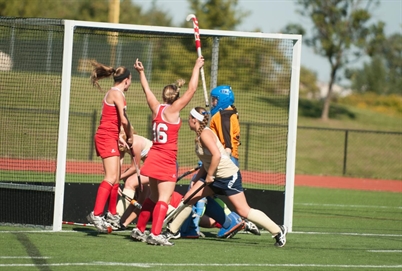
How Good is a Goal
A Guide to Judging the Best from the Rest
Thursday January 11 2018
Recently on the Face-Twit thingy we were asked why the boffins who run the FIH social media account seem to think that every goal highlight that they post is the best goal scored, ever.
Well, we don’t know. We can have a guess though. Which for the moment we will keep to ourselves because that’s not what this editorial is about.
On reflection we began to wonder what exactly a good goal was. How do we rate goals in our game? So we have developed the following guide to understanding goals and how we can best rate them and come up with a definitive ‘Greatest Goal Ever’. Now that shouldn’t be too hard.
Before we start it is worthwhile noting that this guide was written with the premise that any goal is automatically a good goal. From that point it becomes an exercise in style and artistic interpretation. And any goal scored by the authors is immediately a classic.
Over the next couple of weeks we will discuss artistic interpretation and a method of using this information for people to calculate their opinion. First up this week we will look at style.
The Seagull: This goal is becoming more and more popular among forwards, mainly because they don’t have to move much. Consider the goalmouth as fish and chips wrapped in paper, the ball is a chip and the forward is the hungry seagull waiting for the stray chip to drop into their lap. Generally positioned on the back post waiting for the ball to pass through several defenders or for the goalie to stuff it up. There is also a sub grouping to the Seagull, known as the ‘…and two pieces of fish thanks’ for having the last touch on a ball that was going to be a goal anyway. Missing a ‘seagull’ should be a mandatory $5 fine in any team.
The Bibbly-Bobbly: Sadly this goal has almost disappeared from international Hockey. While a form of the Bibbly-Bobbly is seen occasionally the true genius of such a shot is restricted to organic fields. Essentially disguised as a horrible miss-hit or flick, this shot bounces and bobbles on the not exactly flat surface and befuddles the keeper, who inevitably kicks over/under/around the ball as it wobbles over the goal line. The best bibbly's struggle to cross the line, let alone rattle the backboard. Nothing brings tension and anticipation to the game quite like such a shot. All goalies live with a deep fear of the Bibbly-Bobbly.
The Defensive Fuck Up (DFU for the kiddies): This goal is easily recognised. The key is in what happens after the goal is scored. If the defenders appear to wander about aimlessly, much like the preceding play, avoiding eye contact with each other while at the same time the Goalkeeper is waving their arms about manically while yelling something about commitment, effort and ritual suicide, then you have been witness to a DFU. As for the attackers, this is a time for much mirth. It is also closely related to the Seagull.
The Classic: This is the goal you can see coming from 50 metres out, more sometimes. Characterised by precise passing, hard running and clinical finishing, good teams score them often. Not to be confused with ‘the Counter’.
The Counter: To be truly considered a ‘Counter’ a team must be playing behind the ball with only a lone forward standing 50 metres away waiting for the ball to be hit to them. Teams playing on the counter will win the odd game, but never a trophy. Goals scored on the counter are very rarely deserved. Watching two teams both playing the counter is the Hockey equivalent of water boarding.
The Cracker: So named for the sound created when the stick makes contact with the ball. Due to the vagaries of physics, the ‘cracker’ is often seen in the back of the net before the sound of the contact between stick and the ball has been heard by the onlooker. Highly valued by forwards because it feels real good, the Cracker is the goal least likely to cause upset to a goalkeeper, mainly because you can’t stop what you can’t see. Usually they are happy they weren’t in the way.
Then of course there are Penalty Corner goals. There is some confusion over wether or not the Bibbly Bobbly is really just a miss hit penalty corner. Any shot on goal that contains an element of deliberate miss-skill in an attempt to confuse and befuddle the defence, in the opinion of the shot taker, is to be classed as a Bibbly Bobbly. Failure of a player to own up to scoring a Bibbly Bobbly is another $5 fine.
In accessing short corner goals method of delivery is important. Hit, Flick, Drag Flick and the Goalmouth Scramble. A clean trap and hit can often produce a Cracker. Flicking and drag flicking produce the Rocket. A Goal Mouth Scramble, or GMS for texters, can sometimes result in a Seagull, It may also lead to the ‘Got to be Kidding’, ‘He kicked it umpy’ and the well known ‘Saved on the line but bounces in off the back of the goalies leg’.
This is of course far from a complete list. We have left standards, such as the Tomahawk, out for the time being. However it should provide a starting point to any conversation regarding the comparison of goals.
Next week we will continue with a discussion on the role of artistic interpretation in ranking just how good any goal is.







